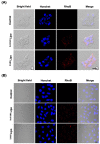Development of ErbB2-Targeting Liposomes for Enhancing Drug Delivery to ErbB2-Positive Breast Cancer
- PMID: 32599712
- PMCID: PMC7356551
- DOI: 10.3390/pharmaceutics12060585
Development of ErbB2-Targeting Liposomes for Enhancing Drug Delivery to ErbB2-Positive Breast Cancer
Abstract
ErbB2 is a type of receptor tyrosine kinase, which is known to be involved in tumorigenesis, tumor aggressiveness, and clinical outcome. ErbB2-targeting therapy using therapeutic antibodies has been successful in breast cancer treatment. However, the need for repeated treatments and the high cost are major disadvantages with monoclonal antibody therapies. Compared with antibodies, peptides are cheap, relatively stable, and have low immunogenicity. We have developed a highly specific cancer-targeting drug delivery system using a targeting peptide to maximize the therapeutic efficiency of rapamycin and to help prevent drug resistance in ErbB2-positive breast cancer. Physicochemical characterization confirmed the successful construction of ErbB2-targeting liposomes (ErbB2Lipo). A comparison of a scrambled peptide (ScrErbB2) with the ErbB2-targeting peptide confirmed that these peptides had similar properties except for the targeting ability. The ErbB2Lipo exhibited higher delivery efficiency in ErbB2 positive BT-474 cells than non-targeting liposomes conjugated with ScrErbB2 (ScrErbB2Lipo). This peptide-targeting strategy has the potential to improve the efficacy of chemotherapy in ErbB2-positive cancers.
Keywords: breast cancer therapy; drug delivery system; immunoliposome; mTOR inhibitor; targeted therapy; targeting peptide.
Conflict of interest statement
The authors declare no conflict of interest.
Figures






References
Grants and funding
- 204030111/International Research Organization for Advanced Science and Technology (IROAST), Kumamoto University
- 20K20203/JSPS KAKENHI
- JPMJCR18H5/Core Research for Evolutional Science and Technology
- 2017R1C1B1010703/National Research Foundation of Korea
- 2019R1A4A2001527/National Research Foundation of Korea
LinkOut - more resources
Full Text Sources
Research Materials
Miscellaneous

